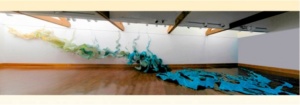This weeks topic is ART.
How great is that? It is a topic near and dear to my heart and to all the Beauties and Beasties. There is no museum in Botaniumus so they have to travel for their “art fixes.” This week we will be chatting about different shows, types of art, reasons for art (?) and feature a few cities and museums through out the week. To answer my own question, it is VERY GREAT that this week is ART! Art helps makes the world go round.

Monday (today) will be about a lovely exhibit in Washington D.C. at The Textile Museum– their tag line is ART • TRADITION • CULTURE • INNOVATION. Already, that is an amazingly great start – and so they kick off our ART week. Our feature Spokes-Creatures this week will be The Blossoms. They stem from Japan, and a culture of beauty. They stand for Unity, Beauty and Strength, as does much art.
Another great reason to start with this museum is they happen to have a great exhibit now. Although The Blossoms did not get go themselves, they have a sister who was able to go. It was an extremely appropriate visit, not only is the city filled with Cherry Blossom Trees lining the mall and neighborhoods (which is art in its self, especially when they are in bloom) but the show at The Textile Museum is “Green the color and the cause.”
The opening words for explanation of the show are: “Many cultures traditionally associate the color green with nature and its attributes, including life, fertility, and rebirth. In recent years, green has become the symbolic color of environmentalism. This exhibition celebrates green both as a color and a cause, exploring the techniques people have devised to create green textiles, the meanings this color has held in cultures across time and place, and the ways that contemporary artists and designers are responding to concerns about the environment.
Despite its ubiquity in nature, green was among the most elusive of hues in the textile arts until the invention of synthetic dyes in the nineteenth century. Textiles from the Museum’s permanent collection, created across the world over the last 1,700 years, illustrate a range of ingenious solutions for creating green fabrics.These historical textiles are juxtaposed with contemporary artworks, primarily chosen from over 1,000 pieces submitted by almost 300 artists through an international call for entries. The artists represent five continents, create in a variety of genres, and approach the concept of green from diverse points of view. Exploring themes such as sustainability, recycling, and the interconnectedness between humans and the natural world, these artists continue today’s “green” conversation by encouraging new ways of seeing, thinking about, and interacting with the environment and this evocative color.”
Below are two examples that begin to show the depth and range of the show. Wording is direct for the Museums website.
Nancy Cohen Estuary: Moods and Modes, 2007
Handmade paper, marsh grasses, salt, wire, handmade abaca paper; assembled
Courtesy of the artist – Photo by Ed Fausty

Water is vital for all life on Earth, and the protection of water resources has become a cornerstone of the environmental movement. Estuary: Moods and Modes reflects the artist’s study of the New Jersey Pine Barrens ecosystem—a million-acre tract of largely undeveloped land in the nation’s most densely populated state. The undulating swirls of delicately colored, handmade abaca paper evoke the ebb and flow of water courses, differing concentrations of salinity, and the shifting boundaries between water and land. The artist states that in this work, as in our own lives, “elements hang in balance, each one necessary, vulnerable, beautiful, and above all interdependent.”
From the modern to the ancient.
Fragmentary roundel – Egypt, Late Roman Period, 4th century
Wool; tapestry woven
The Textile Museum 71.10
Acquired by George Hewitt Myers in 1927

A female figure, possibly a personification of the Earth or one of the four seasons, is dressed appropriately in a cloak of deep green and wearing a necklace of leaves and petals. In her left hand she holds a sheaf of grain or a basket of fruit, and in her right hand a thyrsus—a staff that is a composite symbol of the forest (a pine cone) and the farm (a fennel). Many early cultures around the world envisioned the Earth as a woman, often shown decked in deep green attire.”
◊◊◊
Our own personal guest visitor to the show told me it was a great show. The mix of concepts, the art pieces themselves, and the range clearly thrilled her. I would have to say – if you are in the Washington DC area bike, walk, or metro your way to this GREEN show! Show up by September 11, 2011 or you will be Blue instead of GREEN.
To learn more– What Does “Green” Mean to Artists, Past and Present?
THE TEXTILE MUSEUM
2320 S Street, NW
Washington, DC 20008-4088
http://www.textilemuseum.org/green/


